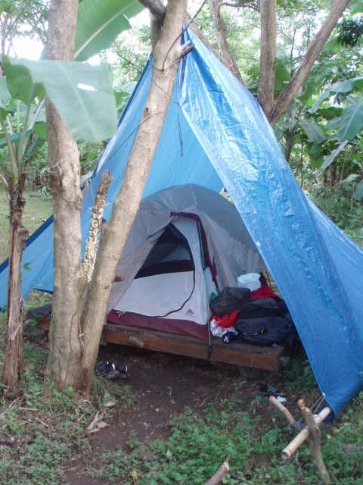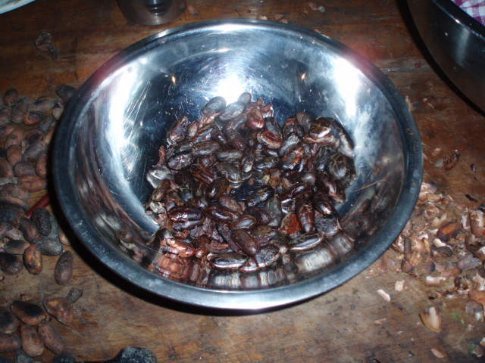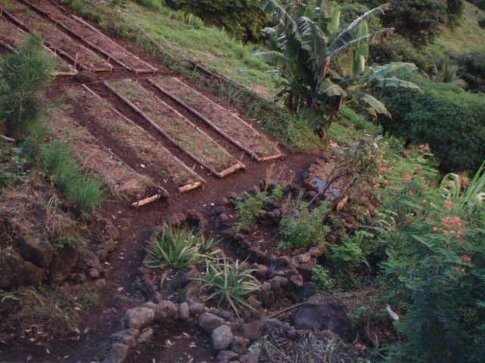Who would have thought I would be spending two weeks in a tent, in a sea of mud, on the side of an extinct volcano, facing another very much active volcano. Well I did. Dan and I volunteered with Finca Bona Fide, a permaculture farm, on the island of Ometepe in Nicaragua. This is Ometepe: two volcanoes with a strip of land in between. It´s is the largest of more than 300 islands on Lake Nicaragua (or Lago Cocibolca meaning “sweet waters” to the locals).
We arrived after some detours - a ferry from Granada to Altagracia, bus to Moyagalpa (the islands´ two towns) and a brief sojourn at Finca Magdalena just next door to Bona Fida. It`s not the easiest place to find. There are no road signs, no direct road access, not even a proper footpath. Imagine a hill-side plot surrounded by a network of stony, muddy cattle tracks instead. Our directions from Magdalena´s were to go straight down a path, then left and right again, we even had a helpful zigzag biro´d onto a paper napkin.
The usefulness of our map became apparent when the path split into at least three directions. It was useless, the whole hillside was a web of interconnecting trails some made by livestock others by people or both. We made our way in the approximate direction, fortunately met a farmer and asked directions and retraced our steps through a field or two, before we finally stumbled across a hillside garden.
Permaculture is the practice of growing plants within an ecosystem approach. That means looking to get the maximum output, without using chemicals (an organic approach), working with contour lines, water catchments, companion and rotation planting, mulching and so on. Leguminous plants fix the nitrogen, mulching saves water and provides compost. Swales cut across along contours slow water run off and capture soil washed down from the fields above. The fine soil is then mixed with homemade compost to make a potting mix. Planting ensures that fruits and vegetables are producing all year, trees, shrubs and garden plots grown together. For example, sweet potatoes were planted next to coffee which itself was shaded by bananas.
Walking along tree lined paths we finally saw signs habitation: a compost toilet, a thatched class room, a nursery and finally an open air, mud floor and thatched kitchen come dining area. This was the hub of the operation where we found the resident interns and volunteers relaxing in the hot damp afternoon hours. Our arrival was unexpected.

The kitchen hub
We had of course attempted to make email contact, but for whatever reason (the server, the weather, who knows?) our message wasn`t received. So we tried our luck and just turned up. Fortunately for us, Heather, a long term intern was leaving the next day and had decided to donate her tent to the Farm. That meant we had somewhere to stay. We agreed to return the next day and home for the next two weeks was a 2-person tent, on platform under a tarpaulin.

Home-sweet-home
When you spend some time in the tropics, especially during the rainy season you learn just how useful tarps are. Our time on Ometepe coincided with the rise of the seasonal wind (usually November – January) and the tail end of the wet season. It was very stormy most nights with spectacular thunder and lightning. A tarp lent an extra sense of security and was pretty useful when a banana tree almost landed on us one night.
Our principle living area was the kitchen-diner, closely followed by the tree platform (under which was the outdoor shower) and the outdoor sinks. We had electricity (solar and wind generated), purified water, a gas stove and a beautiful view of La Conception. The Maderas volcano on which we sat was more usually covered in cloud. Although it was here that we saw our first sunsets in months.

making chocolate with seeds from a cocoa pod
During our time on the farm we worked Monday to Friday in the mornings 7.00am – 8.00am, had breakfast until 8.30am and then worked until 12.00pm. After lunch, cooked for us by Clemencia, we had the rest of the time to ourselves. Our work was manual. There is no machinery here, everything is done by hand. We hauled rocks, moved soil, picked fruits, pruned huge bamboos (awful prickly job), dug holes, weeded cacti, spread mulch, machete´d firewood and so on. Chris, one of the directors of the project started work here 7 years ago. He´s planted hundreds of trees and plants. As they grow (some much faster than others) the farm will evolve and pioneer species like the banana and papaya will give way to fruiting avocados, Surinam cherries, bread fruits and more exotic fare.

Kitchen plots we helped to weed
In the afternoons it was quite nice just to relax, read a book and, well, do nothing. But there was community work too. The Finca supports local children with health supplements and fruits – which is why we found ourselves up at 6.00am one morning making juice for 70 children! They are setting up a community centre and playground too. I had fun one afternoon trying to help Katherine, a long term volunteer, to teach a chaotic bunch of children some English. I have a sneaky suspicion that because I was a new face, I was the distraction…
A team of local workers reported for duty each morning, machetes ready. Their task was to keep the grass down. Everything here grows fast and chopping back the grass helps to control the insect population. The farm was beautiful, but a bug heaven too. Apart from the butterflies (the most we`ve seen were in Nicaragua) I would have gladly exterminated the lot. Sandflies were the worst and happened to be most numerous under the kitchen table. Without long sleeves and long trousers tucked into socks you would be annihilated. Even with the extra layers and a coating of repellent some of the little devils would get you through your clothing. The mosquitos were a neon blue.
If you want to know why we will never settle in Central America, despite its attractions, here is the answer: biting insects. Mosquitos everyone knows about because of malaria, but ants, wasps, fleas, sand flies, spiders and I don´t know how many other ´no-seeums´ all take their toll too. I did mention fleas, didn´t I, well cats and dogs have them (some people too) and I`m a sucker for both. The farm had a loopy dog called Dugo and a cat called Mr Foo, an excellent rater. Dugo tried to chew a porcupine when he, Dan and the others went up the volcano. Luckily his human friends pulled the spines out.
Here´s a short intro video (sorry about the camera-work!):
http://uk.youtube.com/watch?v=K6v7es_rMTs
Click here to go to our Ometepe picture gallery:
http://journals.worldnomads.com/rachel_and_daniel/gallery/13963.aspx